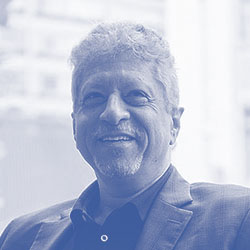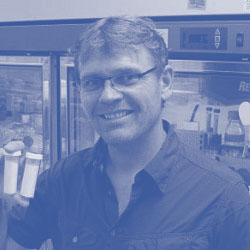These innovators are using their own bodies to build evidence for their hypotheses.
Self-experimentation is likely as old as science itself. And while modern institutional review boards pride themselves on stamping out unethical experiments, they haven’t tamped down the curiosity that drives these fearless few. Historically, self-experiments have driven breakthroughs but have also caused injuries and more than a few deaths. Scientists have self-experimented to avoid red tape, to satisfy their curiosity, to speed their experiments, and out of sheer frustration.
Arguably the most successful example involves the Australian physician Barry Marshall, who discovered that Helicobacter pylori bacteria can cause ulcers and stomach cancer in the 1980s. Early experiments succeeded, yet his colleagues didn’t buy it. Journal reviewers declared the research unpublishable; gastroenterologists at the time were making bank performing repeated endoscopies for ulcers that never healed and found the idea of a bacterial cause simply unbelievable. Marshall tried injecting piglets with H. pylori, but they did not develop ulcers. Finally, he gulped down a cloudy, lukewarm slurry of cultured bacteria in beef broth, guessing he might have ulcers years later. He developed the first symptoms just three days later. His next paper was not only published but widely cited, and he eventually won the Nobel prize in medicine for his bold work.
More recently, researchers developing COVID-19 vaccines claimed to have tested them on themselves during the early days of the pandemic. In mid-2020, several scientists at the Rapid Deployment Vaccine Collaborative self-administered doses of a nasal spray containing an experimental vaccine. The group was formed by scientists who raised an eyebrow at the U.S. government’s 12–18 month timeline for vaccine development. Members told MIT Technology Review that the risks of the virus outweighed those of their experimental vaccine and that a self-developed and self-administered vaccine was outside the FDA’s purview.
Not all experiments are as dramatic as Marshall’s or as urgent as the task of developing a COVID-19 vaccine. Yet every day, scientists who have spent years poring over microscopes carry their findings home, translating their own hypotheses to personal practices. We asked a few to share the everyday habits that have traveled from the lab bench to their personal lives.

Ming Kuo
environmental scientist at University of Illinois
Psychologist Ming Kuo keeps her chin up. Literally. The renowned green space researcher will apologize if she bumps into you on her walks across campus, but she’s far more interested in gazing at tree branches arching overhead than avoiding cracks in the sidewalk.
“It probably looks ridiculous and I’m sure I’m at risk of tripping, but it works,” she says. Kuo’s research shows that green space exposure activates the parasympathetic nervous system, which helps people relax, so she maximizes her exposure whenever she can by staring at treetops as she walks.
“How much time you spend in tend and befriend versus fight or flight is what determines the balance of your immune modality.”
Sometimes described as a “rest and digest” or “tend and befriend” mode, the parasympathetic nervous system is a network of nerves that controls the resting heart rate, breathing rate, and metabolism. When the body is in a state of deep relaxation, Kuo says, it can bolster healthy immune functions like antiviral processes—the opposite of a fight or flight response. In contrast, under high stress, the body is prepared to fend off bacterial invasions or survive wounds, so there’s less investment in long-term immune function. Connecting with nature stimulates relaxation and rebound from stressful jobs and traffic jams.
“This turns out to be really important to health,” Kuo says. “How much time you spend in tend and befriend versus fight or flight is what determines the balance of your immune modality.”

Denis Blondin
integrative physiologist at University of Sherbrooke in Quebec, Canada
While most of us like to relax in a hot shower, Denis Blondin likes to boost his cold adaptation by blasting himself with a minute or two of icy spray at the end. It’s one of the lifestyle shifts he’s made as a result of his explorations into the benefits of cold adaptation and chronic cold exposure. Blondin admits his experiments aren’t comfortable.
“It’s things typically that people wouldn’t willingly do. But if you push yourself to do it or force yourself to do it, you’ll be fine,” he says. Not only fine, but possibly even better off, as cold exposure can boost helpful cold shock proteins. The jury is still out, but Blondin is convinced enough to venture out in a T-shirt even in the early days of cold Canadian winters with an eye to cold adaptation. He’s not the only one; winter swimming boomed during the pandemic, which shut down swimming pools and spiked stress levels. And everyday athletes are exploring the allure of the ice-cold plunge.
Blondin’s research has explored the potential metabolic benefits of cold exposure, which can boost both energy expenditure and insulin sensitivity, the opposite of harmful insulin resistance that can lead to diabetes. He remains curious about the impacts of repeated cold exposure, which have been harder to quantify.
With controlled experiments, scientists are now studying the impact of various durations on glucose regulation, metabolic health, and immune response, with an eye to future anti-obesity and anti-diabetes therapies.

Michelle Colgrave
protein biochemist in Brisbane, Australia
Michelle Colgrave is working to identify novel protein sources for livestock and human diets as global populations boom—and that includes the plentiful insects wriggling all around us. Her job title at CSIRO Agriculture and Food is “future protein lead,” but this proteomics expert isn’t packing her diet with chicken, beef, or pork.
With two billion people already eating insects around the world, Colgrave is bullish on the possibilities of replacing large livestock with tiny bugs as primary protein sources. In high-income, global north nations, “insect products are still few and far between and not common in supermarket products, which limits their adoption in diets,” Colgrave says. But insect-based pet foods are now widely available, and she hopes that insects will ultimately address a frustrating source of food shortage: consumer waste. Insects could snack on overripe produce, then themselves be consumed as a tasty, nutrient- and protein-dense snack.
And if she’s not personally crunching down crickets just yet, that’s more because they’re simply hard to find, though insect farming as an industry is gaining momentum. In the meantime, she’s dropped more than 20 pounds by diversifying her own diet, swapping meat for plant-based proteins and oat milk instead of dairy. She’s open to eating insect products, which she says will likely show up in Australia, the United States, and elsewhere ground into flours and prepared foods, rather than packaged whole on shelves.
And like any food option, Colgrave cautions that even insect-based foods can be unhealthy if they’re heavily processed or made into sugar-laden snacks.

Elizabeth Parrish
biotech CEO of BioViva on Bainbridge Island, Washington
In an effort to convince the FDA (and others) about the safety and efficacy of in vivo gene therapy in humans, Elizabeth Parrish traveled abroad in 2015 and 2020 to undergo four rounds of these injections. Parrish hopes to extend her lifespan by introducing copies of genes associated with telomere lengthening, as well as genes BioViva scientists believe will preserve muscle mass and extend longevity. It’s an ambitious, risky—and some would even say crazy—undertaking. (BioViva lost some of its science advisors in the wake of the experiment.) Parrish is the first known human recipient of in vivo gene therapy designed to extend lifespan, as opposed to treat or eradicate a disease.
“I would accept any outcome, up to and including my own death, in order to move the science forward.”
Parrish told journalist David Warmflash, “I would accept any outcome, up to and including my own death, in order to move the science forward,” in a Discover magazine interview. Warmflash also penned proto.life’s coverage of recent advances in BioViva therapeutics, noting that Parrish remains the only human recipient of this type of gene therapy.
While researchers themselves risk professional stature and possible funding if they sidestep FDA regulations and begin to self-administer or share new therapies, startup execs like Parrish have been more open about their exploits. In fact, Parrish’s initial announcement came not through a press release or interview, but a Reddit thread.

Lou Hawthorne
biotech CEO of NaNotics in Mill Valley, California
As a serial biotech startup founder, Lou Hawthorne is just the kind of person you’d expect to plop down tens of thousands of dollars for experimental therapeutic plasma exchange, infusions designed to slow aging. Hawthorne was part of a clinical trial to test the effectiveness of this therapy, and he found it so effective in shaking off the torpor of aging that he continues to invest in cycles of six infusions spaced a month apart. Each infusion from the Apheresis Care Group takes about two hours and is supervised by physician-researcher Dobri Kiprov.
“It just feels like you’ve come out of a poisonous cloud. You didn’t even realize you were under a poisonous cloud until you come out from under it. So, it’s pretty great,” he says. Each IV contains saline, albumin, and sometimes, immunoglobulin G (Hawthorne opts to skip it), a common antibody that wards off viral and bacterial infections. Using an apheresis procedure that separates yellowish plasma from red blood cells, Hawthorne’s plasma is separated, discarded, and replaced by the saline and albumin mixture.
Hawthorne’s own startup, which shares investors with Kiprov, hopes to harness nanotechnology to develop “the world’s smallest, most specific, programmable, biodegradable sponge” that could soak up harmful byproducts of aging, like inflammatory cytokines, and remove them without replacing the entire plasma volume. The million-dollar question is what to remove, and what to leave behind, he says.

Hans Dreyer
muscle physiologist at University of Oregon
“I experiment on myself all the time,” says metabolic expert Hans Dreyer, who teaches the next generation of physiologists about muscles when he’s not sharing his expertise on sarcopenia. His current obsession, er, research interest, is amino acids, specifically the possibility of dosing patients before surgery to help prevent muscle atrophy.
“I give out that advice and actual supplement to all those I know who are on the older side before surgeries like hip and knee replacements,” he says. His own research has shown that these supplements reduce muscle loss and boost muscular resilience, even during periods of immobilization. He recommends getting closer to more than 1.2 grams per kilogram of body mass of protein each day (“more is not harmful”). That pans out to about 82 grams of protein per day for a 150-pound person.
At home, Dreyer religiously practices planks for 5 minutes, morning and evening, bikes to work, and has experimented with various vegetarian and keto diets, cold plunges, and restricting food intake to the six-hour window from 2 to 8pm.
“I teach metabolism so I like to know how some of the things I read about and teach make me feel,” he says.
As science hurtles forward, the only certainty is that no one scientist is getting it 100 percent right. The COVID-19 vaccines most widely distributed did not wind up being a solution we snorted up our noses, despite those scientists’ self-experimentation. Parents who have bundled up a kid to help them avoid winter illness will not be eager to plunge their swimsuit-clad self into an icy river. The link between cold exposure and immune function, despite much common wisdom, remains frustratingly unclear. Still, a little self-experimentation might just nudge us forward in ways we don’t expect.







































